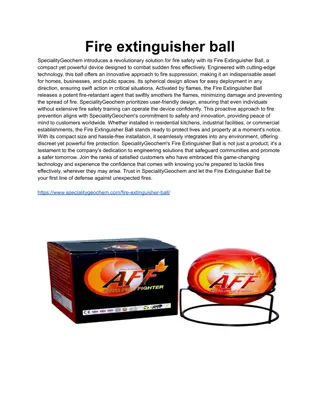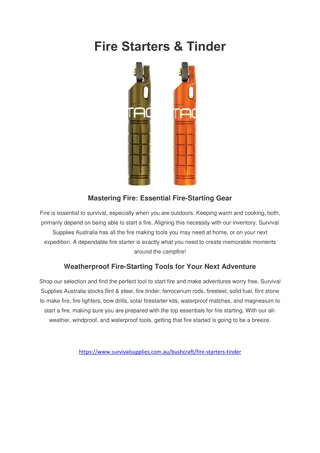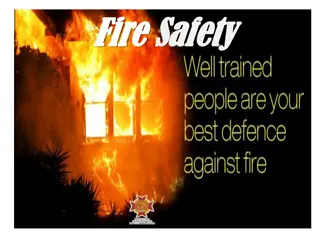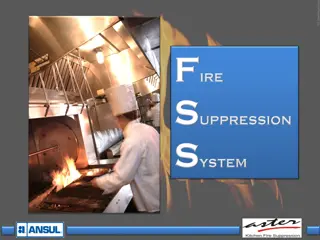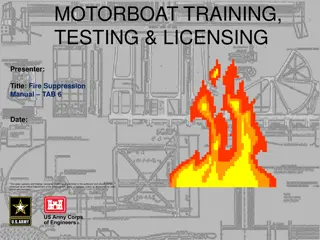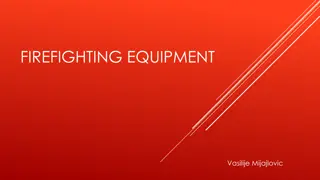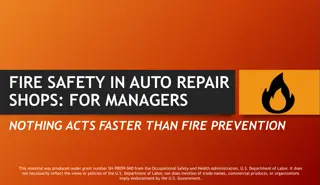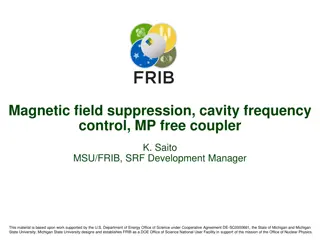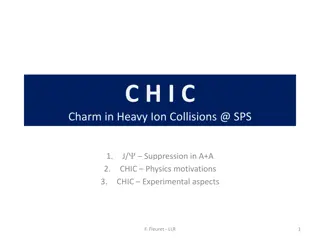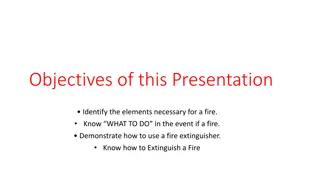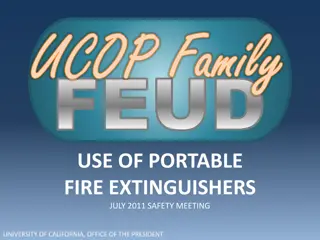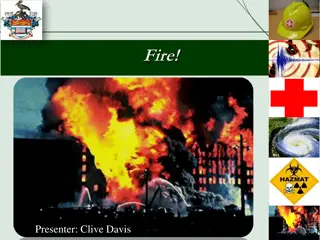Fire Suppression Delivery Platforms and Materials Overview
Various platforms are used to deliver suppressants and retardants to fire areas, each with unique abilities. Aircraft play a crucial role in delivering materials such as retardant, water, foam, and gel for fire suppression. These materials have specific guidelines for use and may pose challenges like introducing harmful species into waterways. Understanding their applications and limitations is essential for effective fire management.
Uploaded on Nov 12, 2024 | 1 Views
Download Presentation

Please find below an Image/Link to download the presentation.
The content on the website is provided AS IS for your information and personal use only. It may not be sold, licensed, or shared on other websites without obtaining consent from the author.If you encounter any issues during the download, it is possible that the publisher has removed the file from their server.
You are allowed to download the files provided on this website for personal or commercial use, subject to the condition that they are used lawfully. All files are the property of their respective owners.
The content on the website is provided AS IS for your information and personal use only. It may not be sold, licensed, or shared on other websites without obtaining consent from the author.
E N D
Presentation Transcript
There are numerous platforms utilized to deliver suppressant and retardant to a fire area. Each has its own unique abilities and functions Within the fire arena.
During fire operations aircraft deliver a number of materials to assist in fire suppression . Primarily there are four being used today they are: Retardant Water Foam Gel
Used to treat fuels ahead of the fire is rarely dropped directly on the fire Is to be kept 300 ft. from open waterways Retardant avoidance areas are specific to Forest Service only Chemical makeup varies by product and manufacturer
Issues include: Introduction and spread of introduced and harmful species into streams and lakes Hazmat associated with mechanized equipment Private inholdings and use during fie operations
Product mixed with water then delivered to fire. In many cases it is injected before release from tank or bucket Primarily delivered with rotor wing aircraft Is dropped on the fire as a suppressant Harmful to aquatic life as it acts as a surfactant Is not to be used closer then 300 feet to open water.
Product mixed with water in a tank then delivered to the fire as a suppressant Primarily delivered in fixed wing aircraft as a substitute for retardant Is a polymer based product that does not biodegrade is not as harmful to aquatic life as foam will reconstitute when rewetted 300 ft. buffer from open water required
Aircraft have the potential to transport and spread aquatic invasive species. The objective of all Invasives Plans is to prevent introduction of new species to an eco system and prevent the spread of known invasives to uninfected areas. As a READ it is important to know what the invasives are in your areas Be prepared with the required mitigation methods work with the local FAO/UAO on building a plan that can be implemented Know where the hot spots are to avoid Have a supply of any special chemicals or washing agents that are not readily available Ensure equipment is clean and inspected before it is used in your area
The primary use of rotor wing aircraft transporting water is to deliver it to a fire. Transition from one water body to another can be mitigated in a number of ways. They include: Pre-identification of dip sites and washing protocols A plan for dealing with in coming aircraft for inspection and cleaning. Mapping areas of concern and hot spots to avoid Understanding the system snorkel, bucket, bucket with torx valve READS with a knowledge of the areas and concerns, types of aquatics that exist in the area are key in successful mitigation measures
CL-215 and 415 are becoming more common as a suppression tool. These aircraft can deliver large quantities of water to a fire and have the potential to quickly move from one body of water to another with out landing or refueling. As this is a newer tool for many areas use will be a learning experience.
Potential Problems: Water being dropped from a lake into a stream which flows into a different drainage. Spreading surface invasives such as milfoil mats Spreading invasives from one lake to another as the overflow during pickup is put into the water body. Many of these aircraft work in areas where zebra mussels are present in the water Forest Service is contracting more of these resources then in previous years
If you work in an area that has the potential to use the aircraft the following measures and pre-planning help in the prevention of introduction and spread of invasives Have a plan for pre use inspection, cleaning and use Have scooping areas pre-identified and inspected for invasives. If you use an infected area then have a plan and equipment available to cleanse the system Once use is completed ensure aircraft is cleaned before it leaves or moves to a new body of water. Discuss with FAO/UAO of potential areas that could be used and build a plan to manage the resources once they arrive. Pre-planning is the key to success



